Min Wang
Wavelet Predictive Representations for Non-Stationary Reinforcement Learning
Oct 06, 2025Abstract:The real world is inherently non-stationary, with ever-changing factors, such as weather conditions and traffic flows, making it challenging for agents to adapt to varying environmental dynamics. Non-Stationary Reinforcement Learning (NSRL) addresses this challenge by training agents to adapt rapidly to sequences of distinct Markov Decision Processes (MDPs). However, existing NSRL approaches often focus on tasks with regularly evolving patterns, leading to limited adaptability in highly dynamic settings. Inspired by the success of Wavelet analysis in time series modeling, specifically its ability to capture signal trends at multiple scales, we propose WISDOM to leverage wavelet-domain predictive task representations to enhance NSRL. WISDOM captures these multi-scale features in evolving MDP sequences by transforming task representation sequences into the wavelet domain, where wavelet coefficients represent both global trends and fine-grained variations of non-stationary changes. In addition to the auto-regressive modeling commonly employed in time series forecasting, we devise a wavelet temporal difference (TD) update operator to enhance tracking and prediction of MDP evolution. We theoretically prove the convergence of this operator and demonstrate policy improvement with wavelet task representations. Experiments on diverse benchmarks show that WISDOM significantly outperforms existing baselines in both sample efficiency and asymptotic performance, demonstrating its remarkable adaptability in complex environments characterized by non-stationary and stochastically evolving tasks.
Optimizing for the Shortest Path in Denoising Diffusion Model
Mar 06, 2025Abstract:In this research, we propose a novel denoising diffusion model based on shortest-path modeling that optimizes residual propagation to enhance both denoising efficiency and quality. Drawing on Denoising Diffusion Implicit Models (DDIM) and insights from graph theory, our model, termed the Shortest Path Diffusion Model (ShortDF), treats the denoising process as a shortest-path problem aimed at minimizing reconstruction error. By optimizing the initial residuals, we improve the efficiency of the reverse diffusion process and the quality of the generated samples. Extensive experiments on multiple standard benchmarks demonstrate that ShortDF significantly reduces diffusion time (or steps) while enhancing the visual fidelity of generated samples compared to prior arts. This work, we suppose, paves the way for interactive diffusion-based applications and establishes a foundation for rapid data generation. Code is available at https://github.com/UnicomAI/ShortDF
Bright-NeRF:Brightening Neural Radiance Field with Color Restoration from Low-light Raw Images
Dec 19, 2024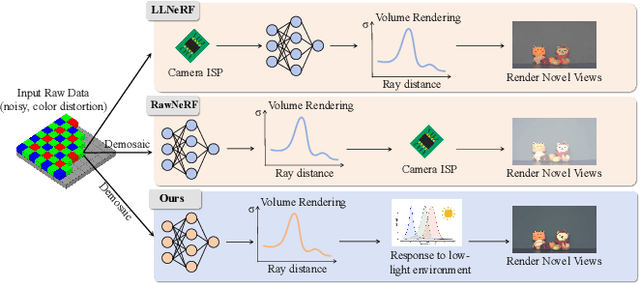



Abstract:Neural Radiance Fields (NeRFs) have demonstrated prominent performance in novel view synthesis. However, their input heavily relies on image acquisition under normal light conditions, making it challenging to learn accurate scene representation in low-light environments where images typically exhibit significant noise and severe color distortion. To address these challenges, we propose a novel approach, Bright-NeRF, which learns enhanced and high-quality radiance fields from multi-view low-light raw images in an unsupervised manner. Our method simultaneously achieves color restoration, denoising, and enhanced novel view synthesis. Specifically, we leverage a physically-inspired model of the sensor's response to illumination and introduce a chromatic adaptation loss to constrain the learning of response, enabling consistent color perception of objects regardless of lighting conditions. We further utilize the raw data's properties to expose the scene's intensity automatically. Additionally, we have collected a multi-view low-light raw image dataset to advance research in this field. Experimental results demonstrate that our proposed method significantly outperforms existing 2D and 3D approaches. Our code and dataset will be made publicly available.
Superpixel-informed Implicit Neural Representation for Multi-Dimensional Data
Nov 18, 2024Abstract:Recently, implicit neural representations (INRs) have attracted increasing attention for multi-dimensional data recovery. However, INRs simply map coordinates via a multi-layer perception (MLP) to corresponding values, ignoring the inherent semantic information of the data. To leverage semantic priors from the data, we propose a novel Superpixel-informed INR (S-INR). Specifically, we suggest utilizing generalized superpixel instead of pixel as an alternative basic unit of INR for multi-dimensional data (e.g., images and weather data). The coordinates of generalized superpixels are first fed into exclusive attention-based MLPs, and then the intermediate results interact with a shared dictionary matrix. The elaborately designed modules in S-INR allow us to ingenuously exploit the semantic information within and across generalized superpixels. Extensive experiments on various applications validate the effectiveness and efficacy of our S-INR compared to state-of-the-art INR methods.
Machine Learning Aided Modeling of Granular Materials: A Review
Oct 18, 2024Abstract:Artificial intelligence (AI) has become a buzz word since Google's AlphaGo beat a world champion in 2017. In the past five years, machine learning as a subset of the broader category of AI has obtained considerable attention in the research community of granular materials. This work offers a detailed review of the recent advances in machine learning-aided studies of granular materials from the particle-particle interaction at the grain level to the macroscopic simulations of granular flow. This work will start with the application of machine learning in the microscopic particle-particle interaction and associated contact models. Then, different neural networks for learning the constitutive behaviour of granular materials will be reviewed and compared. Finally, the macroscopic simulations of practical engineering or boundary value problems based on the combination of neural networks and numerical methods are discussed. We hope readers will have a clear idea of the development of machine learning-aided modelling of granular materials via this comprehensive review work.
P-RAG: Progressive Retrieval Augmented Generation For Planning on Embodied Everyday Task
Sep 17, 2024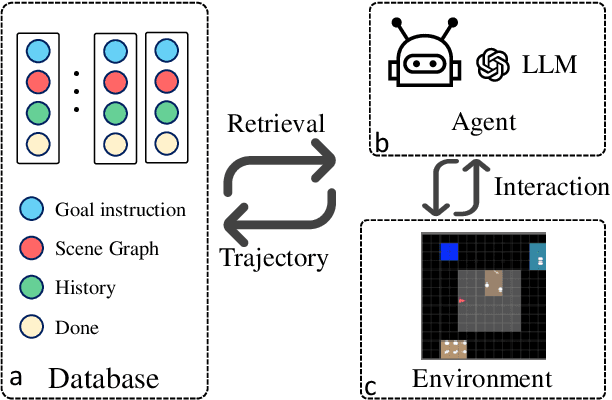
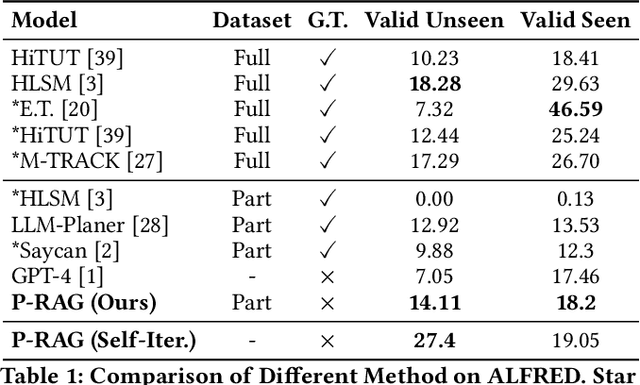
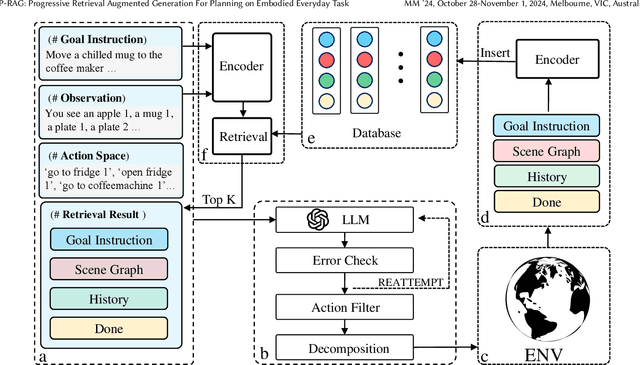
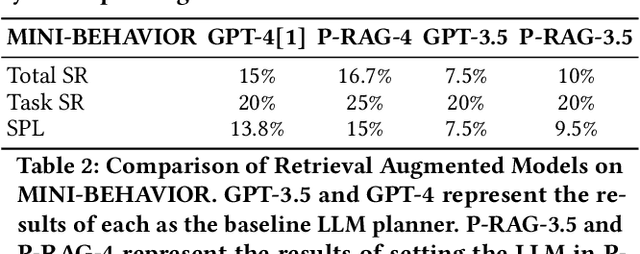
Abstract:Embodied Everyday Task is a popular task in the embodied AI community, requiring agents to make a sequence of actions based on natural language instructions and visual observations. Traditional learning-based approaches face two challenges. Firstly, natural language instructions often lack explicit task planning. Secondly, extensive training is required to equip models with knowledge of the task environment. Previous works based on Large Language Model (LLM) either suffer from poor performance due to the lack of task-specific knowledge or rely on ground truth as few-shot samples. To address the above limitations, we propose a novel approach called Progressive Retrieval Augmented Generation (P-RAG), which not only effectively leverages the powerful language processing capabilities of LLMs but also progressively accumulates task-specific knowledge without ground-truth. Compared to the conventional RAG methods, which retrieve relevant information from the database in a one-shot manner to assist generation, P-RAG introduces an iterative approach to progressively update the database. In each iteration, P-RAG retrieves the latest database and obtains historical information from the previous interaction as experiential references for the current interaction. Moreover, we also introduce a more granular retrieval scheme that not only retrieves similar tasks but also incorporates retrieval of similar situations to provide more valuable reference experiences. Extensive experiments reveal that P-RAG achieves competitive results without utilizing ground truth and can even further improve performance through self-iterations.
Robust Simultaneous Multislice MRI Reconstruction Using Deep Generative Priors
Jul 31, 2024



Abstract:Simultaneous multislice (SMS) imaging is a powerful technique for accelerating magnetic resonance imaging (MRI) acquisitions. However, SMS reconstruction remains challenging due to the complex signal interactions between and within the excited slices. This study presents a robust SMS MRI reconstruction method using deep generative priors. Starting from Gaussian noise, we leverage denoising diffusion probabilistic models (DDPM) to gradually recover the individual slices through reverse diffusion iterations while imposing data consistency from the measured k-space under readout concatenation framework. The posterior sampling procedure is designed such that the DDPM training can be performed on single-slice images without special adjustments for SMS tasks. Additionally, our method integrates a low-frequency enhancement (LFE) module to address a practical issue that SMS-accelerated fast spin echo (FSE) and echo-planar imaging (EPI) sequences cannot easily embed autocalibration signals. Extensive experiments demonstrate that our approach consistently outperforms existing methods and generalizes well to unseen datasets. The code is available at https://github.com/Solor-pikachu/ROGER after the review process.
SEDS: Semantically Enhanced Dual-Stream Encoder for Sign Language Retrieval
Jul 23, 2024



Abstract:Different from traditional video retrieval, sign language retrieval is more biased towards understanding the semantic information of human actions contained in video clips. Previous works typically only encode RGB videos to obtain high-level semantic features, resulting in local action details drowned in a large amount of visual information redundancy. Furthermore, existing RGB-based sign retrieval works suffer from the huge memory cost of dense visual data embedding in end-to-end training, and adopt offline RGB encoder instead, leading to suboptimal feature representation. To address these issues, we propose a novel sign language representation framework called Semantically Enhanced Dual-Stream Encoder (SEDS), which integrates Pose and RGB modalities to represent the local and global information of sign language videos. Specifically, the Pose encoder embeds the coordinates of keypoints corresponding to human joints, effectively capturing detailed action features. For better context-aware fusion of two video modalities, we propose a Cross Gloss Attention Fusion (CGAF) module to aggregate the adjacent clip features with similar semantic information from intra-modality and inter-modality. Moreover, a Pose-RGB Fine-grained Matching Objective is developed to enhance the aggregated fusion feature by contextual matching of fine-grained dual-stream features. Besides the offline RGB encoder, the whole framework only contains learnable lightweight networks, which can be trained end-to-end. Extensive experiments demonstrate that our framework significantly outperforms state-of-the-art methods on various datasets.
DTR: A Unified Deep Tensor Representation Framework for Multimedia Data Recovery
Jul 07, 2024



Abstract:Recently, the transform-based tensor representation has attracted increasing attention in multimedia data (e.g., images and videos) recovery problems, which consists of two indispensable components, i.e., transform and characterization. Previously, the development of transform-based tensor representation mainly focuses on the transform aspect. Although several attempts consider using shallow matrix factorization (e.g., singular value decomposition and negative matrix factorization) to characterize the frontal slices of transformed tensor (termed as latent tensor), the faithful characterization aspect is underexplored. To address this issue, we propose a unified Deep Tensor Representation (termed as DTR) framework by synergistically combining the deep latent generative module and the deep transform module. Especially, the deep latent generative module can faithfully generate the latent tensor as compared with shallow matrix factorization. The new DTR framework not only allows us to better understand the classic shallow representations, but also leads us to explore new representation. To examine the representation ability of the proposed DTR, we consider the representative multi-dimensional data recovery task and suggest an unsupervised DTR-based multi-dimensional data recovery model. Extensive experiments demonstrate that DTR achieves superior performance compared to state-of-the-art methods in both quantitative and qualitative aspects, especially for fine details recovery.
MASA: Motion-aware Masked Autoencoder with Semantic Alignment for Sign Language Recognition
May 31, 2024



Abstract:Sign language recognition (SLR) has long been plagued by insufficient model representation capabilities. Although current pre-training approaches have alleviated this dilemma to some extent and yielded promising performance by employing various pretext tasks on sign pose data, these methods still suffer from two primary limitations: 1) Explicit motion information is usually disregarded in previous pretext tasks, leading to partial information loss and limited representation capability. 2) Previous methods focus on the local context of a sign pose sequence, without incorporating the guidance of the global meaning of lexical signs. To this end, we propose a Motion-Aware masked autoencoder with Semantic Alignment (MASA) that integrates rich motion cues and global semantic information in a self-supervised learning paradigm for SLR. Our framework contains two crucial components, i.e., a motion-aware masked autoencoder (MA) and a momentum semantic alignment module (SA). Specifically, in MA, we introduce an autoencoder architecture with a motion-aware masked strategy to reconstruct motion residuals of masked frames, thereby explicitly exploring dynamic motion cues among sign pose sequences. Moreover, in SA, we embed our framework with global semantic awareness by aligning the embeddings of different augmented samples from the input sequence in the shared latent space. In this way, our framework can simultaneously learn local motion cues and global semantic features for comprehensive sign language representation. Furthermore, we conduct extensive experiments to validate the effectiveness of our method, achieving new state-of-the-art performance on four public benchmarks.
 Add to Chrome
Add to Chrome Add to Firefox
Add to Firefox Add to Edge
Add to Edge